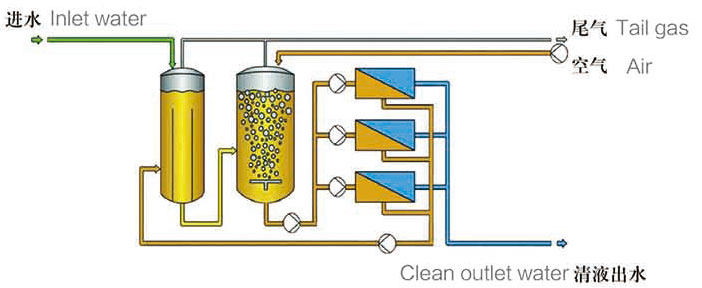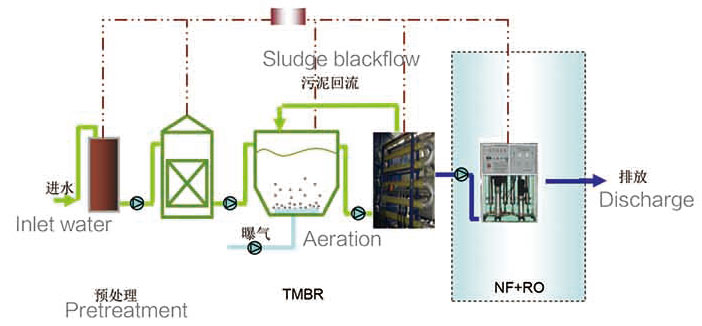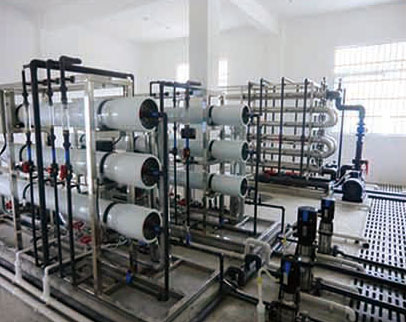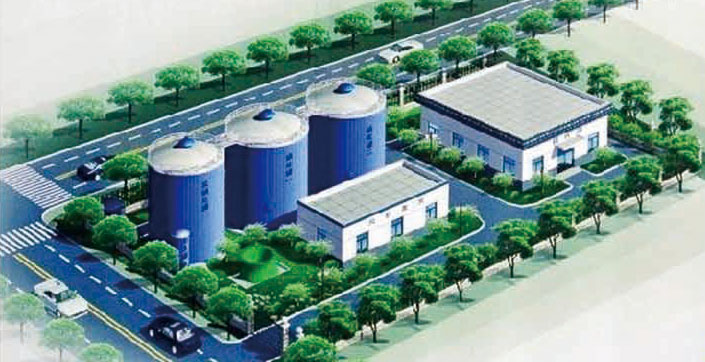联系我们/CONTACT US
宜兴中天宸环境工程有限公司
地址:江苏省宜兴市东氿大厦16楼
手机:18888035000(陈先生)
13906158283(史先生)
15861515998(丁先生)
电话:0510-68531808
传真:0510-68531898
网址:www.ztchb.com
邮箱:ztchjgc@126.com
Yixing Zhongtianchen Environmental Engineering Co.,Ltd.
Address:16th Floor,Mansion of Dongjiu,Yixing City,Jiangsu Province
Mob:18888035000(Mr.Chen)
13906158283(Mr.Shi)
15861515998(Mr.Ding)
Tel:0510-68531808
Fax:0510-68531898
Website: www.ztchb.com
Email: ztchjgc@126.com
垃圾渗滤液处理工艺
垃圾渗滤液处理工艺 Landfill leachate treatment process
渗沥液处理主体工艺为“外置式MBR+纳滤+反渗透”
The main process of leachate treatment is “external MBR+ nanofiltration + reverse osmosis”
一、MBR工艺原理

膜生物反应器工艺(简称MBR)是一种将膜分离技术和传统生化方法进行有机结合的新型水处理技术。
MBR系统的超滤部分采用德国BERGHOF公司的管式超滤膜,其过滤孔径为0.03 u m,可以有效截留所有的微生物菌体和悬浮物。同时,超滤系统可以对大颗粒的有机污染物进行截留,进一步保证MBR系统出水的稳定。本套超滤系统采用大流量高速循环的方式,膜管内的水力流速达到3-5m/s,可以有效的防止污染物的沉积,减少膜污染的风险,延长膜使用寿命。
MBR的主要特点:
▲主要污染物COD,BOD和氨氮有效降解,无二次污染;
▲反应器高效集成,占地面积小,运行费用合理;
▲100%生物菌体分离;出水无细菌和固性物;
▲污泥负荷( F/M)低,剩余污泥量小;
MBR系统采用的反硝化+硝化工艺可以很好的对渗沥液废水中的氨氮、有机污染物进行有效脱除。其中氨氮的脱除率可达到99%以上,有机污染物脱除率达到92%以上。整个系统可以全年运行,并能保证处理效果的稳定,系统的膜使用寿命保证达到5年以上。
MBR process principle
Membrane Bioreactor Process (MBR) is a new type of water treatment technology that combines membrane separation technology with traditional biochemical methods.
The ultrafiltration part of the MBR system adopts the tubular ultrafiltration membrane of BERGHOF Company in Germany. Its filtration pore size is 0.03 u m, which can effectively intercept all microbial cells and suspended solids. At the same time, the ultrafiltration system can intercept large particles of organic pollutants to further ensure the stability of the MBR system. The ultrafiltration system adopts a large-flow high-speed circulation method, with a hydraulic flow rate in the membrane tube of 3-5 m/s, which can effectively prevent the deposition of pollutants, reduce the risk of membrane pollution, and prolong the service life of the membrane.
Main characteristics of MBR:

▲The main pollutants COD, BOD and ammonia nitrogen are effectively degraded without secondary pollution;
▲The reactor is highly integrated, with small land occupation and reasonable operating cost.
▲ 100% biological cell separation; no bacteria or solids in the outlet water;
▲The sludge load (F/M) is low and the amount of excess sludge is small;
The denitrification and nitrification process adopted in the MBR system can effectively remove ammonia nitrogen and organic pollutants from the leachate wastewater. Among them, the removal rate of ammonia nitrogen reaches more than 99%, and the removal rate of organic pollutants reaches over 92%. The entire system can be operated all year round, with stable treatment effect. The membrane life of the system is guaranteed to reach more than 5 years.
二、NF+RO工艺原理

纳滤、反渗透处理工艺作为常用的水处理手段,已经在许多水处理行业中得到成功应用。反渗透属于膜分离技术范畴,其采用的是过滤孔径为0.1nm的反渗透膜。
膜分离技术主要是利用过滤膜的微小过滤孔径,在压力作用下对混合液进行浓缩分离得到部分浓度较低的产水和浓度较高的浓缩液。其作用的理论基础是膜对物质的选择透过性,即清水及小分子物质允许通过,大分子物质及颗粒物质被全部截留。膜分离技术可以有效的对水中的污染物截留浓缩并得到较为洁净的产品水。根据理论分析,反渗透膜的切割分子量等级为20D,即反渗透膜0.1nm过滤孔径可以保证膜对分子量大于20D的物质颗粒有90%以上的去除率。
反渗透工艺在许多工程中得到成功应用。在这套工艺中,污水经过反渗透系统进行浓缩分离去除绝大部分有机污染和大部分盐份,其产品水质可以达到一个很高的条件。结合本工程实际情况来看,反渗透系统可以对污水中分子量大于20D的有机污染物大量截留。经过反渗透系统的过滤,其产水中的有机物含量已经在一个比较低的程度,大分子物质全部被截留形成浓缩液另行处置;盐分物质也被去除掉95%以上,一价盐的稳定去除率也在80%以上,形成的产品水水质可以稳定达到目标标准的要求。
NF+RO process principle
Nanofiltration and reverse osmosis treatment processes, as common water treatment methods, have been successfully applied in many water treatment industries. Reverse osmosis belongs to the field of membrane separation technology, which uses a reverse osmosis membrane with a filtration pore size of 0.1 nm.
Membrane separation technology mainly uses the tiny filtration pore size of the filtration membrane to concentrate and separate the mixed liquid under pressure to obtain a lower concentration of water and a higher concentration of concentrated liquid. The theoretical basis of its action is the selective permeability of the membrane to the substances, that is, the water and small molecular substances are allowed to pass through, and the large molecular substances and the particulate substances are all intercepted. Membrane separation technology can effectively intercept and concentrate pollutants in water and obtain relatively clean product water. According to the theoretical analysis, the grade of molecular weight cut off of the reverse osmosis membrane is 20D, that is, the 0.1 nm filtration pore size of the reverse osmosis membrane can ensure that the membrane has a removal rate of more than 90% for the particles having a molecular weight greater than 20D.
Reverse osmosis process has been successfully applied in many projects. In this process, the wastewater is concentrated and separated by a reverse osmosis system to remove most of the organic pollution and most of the salt, with the product water quality reaching a very high level. Combined with the actual situation of the project, the reverse osmosis system can intercept a large amount of organic pollutants with a molecular weight greater than 20D in the wastewater. After filtration by the reverse osmosis system, the organic matter content in the produced water is already at a relatively low level, and the large molecular substances are intercepted to form a concentrated liquid for further treatment; the salt substances are also removed by more than 95%, and the stable removal rate of the monovalent salt is more than 80%. The produced water quality can stably meet the requirements of the target standard.


